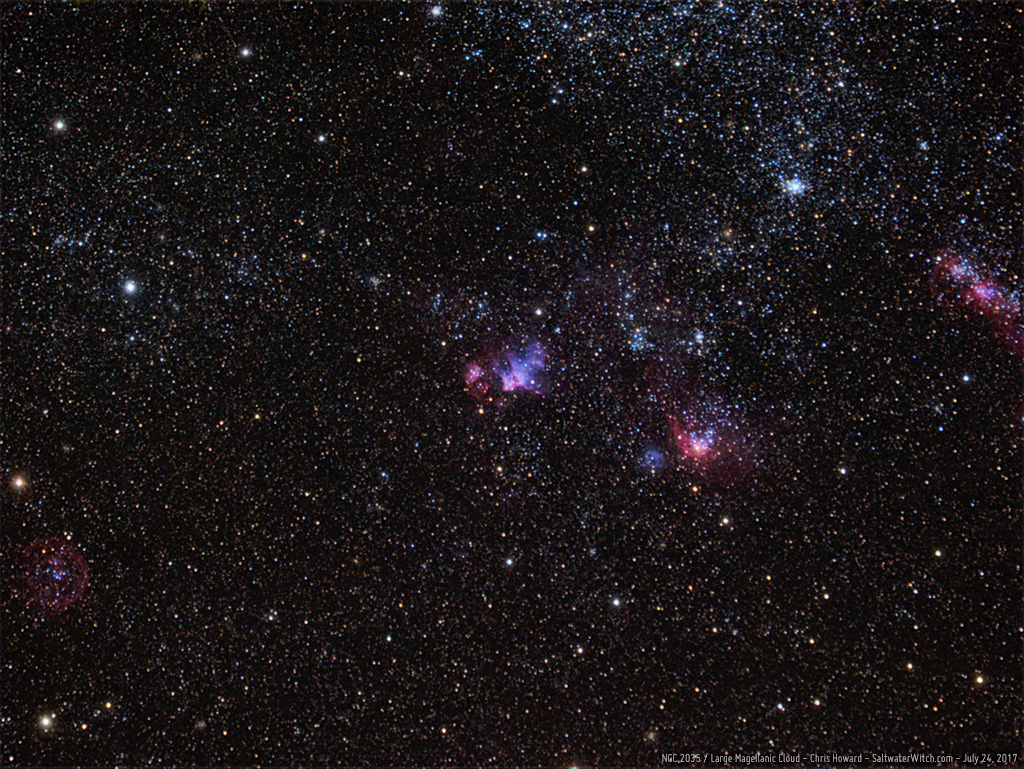Very wide-angle view of the sky
Here's my first night out with the Irix 15mm f/2.4 Blackstone (the heavier, more durable, aluminum and magnesium alloy housing version of this lens). And I'm impressed with just a few shots, wide-open aperture, and single 15 - 20 second exposures--no tripod, although I rested the Nikon on the deck railing.




Posted August 31, 2019
Astro Session - May 18, 2018
We have not had a really clear night for a month, and last night was still fairly poor for imaging. Even so, I set up the ZWOASI071C paired with a Nikon 24-85mm lens to see what I could capture for a wide-field shot centered on the star Deneb in the constellation Cygnus. This area of the Milky Way just happens to be surrounded by some distinctive clouds of ionized hydrogen, including the North America Nebula (NGC7000) and the Pelican Nebula (IC 5070). Both of these are pretty faint, but they are large, so if you stack enough frames you can bring out enough to see why NGC7000 was given its name. For size comparison, the North America Nebula is four times the size of a full moon. (122 stacked 30 sec. frames, ZWO ASI071MC cooled CMOS camera, iOptron CEM25P EQ mount, Nikon 24-85mm F/3.5-4.5 ED lens @ 85mm. Location: Stratham, New Hampshire, US. Bortle ~4)

Posted May 18, 2018
Astro Session - May 7, 2018
Last night I tested out an inexpensive super-wide-angle 6mm C-mount lens hooked up to my QHYIII178 color CMOS camera (without the IR cut filter, which is why the trees are a bit odd looking). It was pretty cloudy to start and the whole view was fogged in by 3am, but I still managed to get the Milky Way as it was sweeping up and across the sky. This camera + lens would make a nice all-sky type setup, but I'm thinking about using this to capture the full night sky when we have meteor showers--the Lyrids, Perseids, Geminids. This shot is from one of the third-floor windows, facing east. (Our attic is finished). I can stick the camera with a long USB3 cable on the end of an 8-foot length of PVC pipe--out the same window--to get it above the roof of the house and get the whole sky in view. Then I can use SharpCap (https://www.sharpcap.co.uk) to capture several thousand 10-second frames over the course of the night, and bring them together into a video.
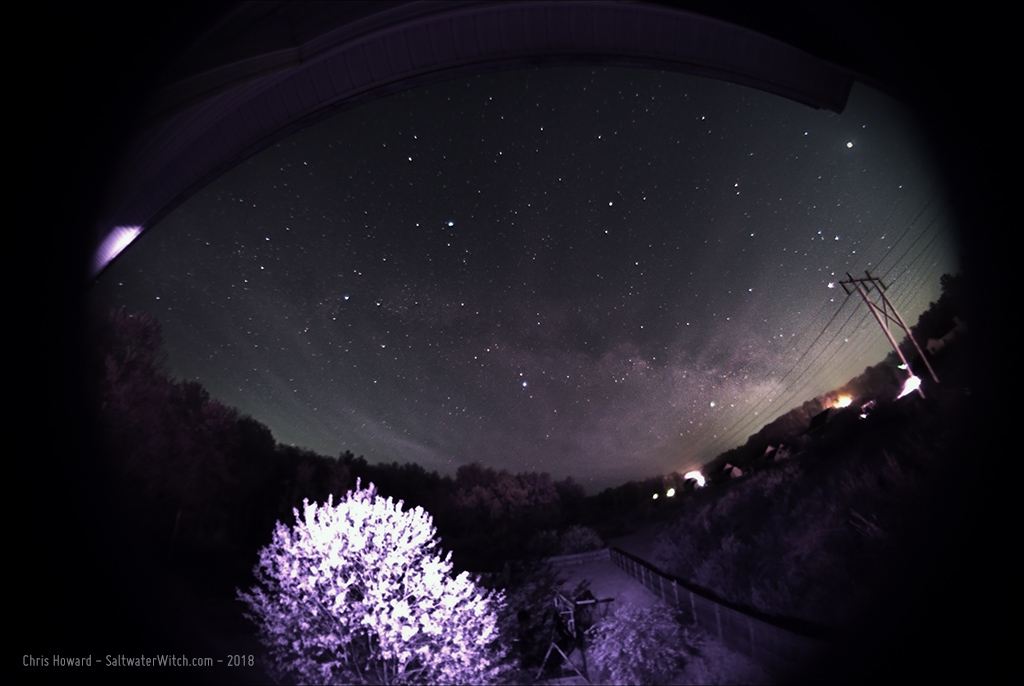
Now with video and me talking! Night Sky Video test with the QHYIII178C CMOS camera and 6mm wide-angle lens--with me yapping about the camera and other equipment, explaining settings and other interesting stuff about this all-sky setup. My plan is to use this the next time our planet's orbit takes us through the path of some comet's orbit. (one of the ways we get seasonal meteor showers).
Watch the full video:
Posted May 7, 2018
Astro Session - April 5, 2018
As the days become longer, as we swing around our sun, headed for aphelion in July (greatest distance from the sun), and our planet's 23.5 degree tilt is angled toward its rays, we'll be seeing less of the constellation Orion--in normal viewing hours. I took this 30 second exposure last night around 9PM, and Orion is already moving below the trees to the southwest. That's the Pleiades (M45) at the far right. I also happened to capture the headlights and brakelights of Alice's car as she's driving past to our driveway, almost home after picking up Christopher from work.

Posted April 5, 2018
Astro Session - February 16, 2018
I took the Nikon D750 out tonight and got a nice 30 second exposure of the constellation Orion (upper right of the first image), with some of the PSNH transmission lines in the foreground. That's Sirius almost center in the shot, with Procyon on the upper left. Centered in the image about a quarter of the way from the top, there's a reddish blur between the star Procyon and the star Betelgeuse in Orion--that's the Rosette Nebula--see my December 26 post. (Nikon D750, 24mm, Hoya LiPo filter, f/4.5, 30 sec. exp. ISO 800). The second shot is M44, the Beehive Cluster in the constellation Cancer--plus a few more stars. (Nikon D750, 24mm, Hoya LiPo filter, f/4.5, 1 x 300 second exposure, ISO 800). These are both single exposures, and I shot both on the iOptron CEM25P mount, and what amazed me was that, with pretty good polar alignment, just using the polar scope (no drift or polemaster), I was able to get 3 and 4 minute exposures unguided. The M44 shot is 300 seconds (5 minutes) with some slight star elongation, but still not a bad shot.


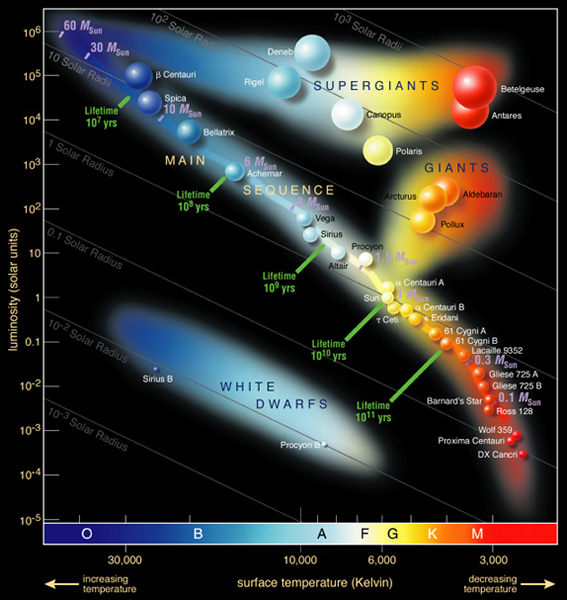 The color of stars is interesting to look for--take a closer look at the Beehive Cluster (M44) image and it's easy to see that the star-field is full of color. I think there's this notion that stars are white pin-points of light in the night sky, but every star has a color, most of them ranging from red to deep blue, depending on many factors including where in its life-cycle it is, the materials it's made from, size, and more. See the Hertzsprung-Russell diagram, listing some of the more familiar stars in our galaxy by surface temperature and luminosity. Our star, the Sun, is pretty close to the middle of the Main Sequence line, between cooler, redder stars and the hotter blue stars. What's interesting is that the shot of the constellation Orion I took the other night--included here--contains several of these stars from the diagram. If you start at the Sun and follow the Main Sequence line up toward the blue end, you will quickly find Procyon, which is the bright star in the top left corner of my image. Sirius--in the diagram--is a couple up from there, but it's almost in the center of my shot. Keep going into the blue, and there's Bellatrix, the blue star which makes up Orion's right shoulder. Now head right from there, out of the Main Sequence line and into the Supergiants, and find the blue supergiant Rigel, which makes up Orion's right foot. And finally, keep going right to the massive red supergiant, Betelgeuse ("Beetle-juice"), which is the left shoulder of Orion. (Hertzsprung-Russell diagram source: ESO - European Southern Observatory, ). How's that for taking one picture of the night sky with some nice examples of stars of varying size, color, and lifespan?
The color of stars is interesting to look for--take a closer look at the Beehive Cluster (M44) image and it's easy to see that the star-field is full of color. I think there's this notion that stars are white pin-points of light in the night sky, but every star has a color, most of them ranging from red to deep blue, depending on many factors including where in its life-cycle it is, the materials it's made from, size, and more. See the Hertzsprung-Russell diagram, listing some of the more familiar stars in our galaxy by surface temperature and luminosity. Our star, the Sun, is pretty close to the middle of the Main Sequence line, between cooler, redder stars and the hotter blue stars. What's interesting is that the shot of the constellation Orion I took the other night--included here--contains several of these stars from the diagram. If you start at the Sun and follow the Main Sequence line up toward the blue end, you will quickly find Procyon, which is the bright star in the top left corner of my image. Sirius--in the diagram--is a couple up from there, but it's almost in the center of my shot. Keep going into the blue, and there's Bellatrix, the blue star which makes up Orion's right shoulder. Now head right from there, out of the Main Sequence line and into the Supergiants, and find the blue supergiant Rigel, which makes up Orion's right foot. And finally, keep going right to the massive red supergiant, Betelgeuse ("Beetle-juice"), which is the left shoulder of Orion. (Hertzsprung-Russell diagram source: ESO - European Southern Observatory, ). How's that for taking one picture of the night sky with some nice examples of stars of varying size, color, and lifespan?
Posted February 16, 2018
Astro Session - February 11, 2018
It's been a cloudy week, and the seven days ahead don't look much better. So I'm digging through some wide-field frames from last summer--to stack and process, and I particularly love this small section of our galaxy, the Milky Way. We are about 26,000 lightyears from the center of our galaxy, all of us on our little blue planet orbiting a G-type main-sequence star. And if you're looking inward, toward the galactic center from our world, you'll see something like the image here (this is a crop of a much wider field of view, so you'll actually see much more, that well-known and aptly-named long pale band across the sky). We are right in the thick of things with our galaxy, which is well over a 100,000 lightyears across and contains as many as 400 billion stars. To put the size of our galaxy in perspective (and keep in mind that 100,000 lightyears is the low side of the approximate diameter, calculated to be between 100,000 and 180,000 lightyears across), we are talking about 587,863,000,000,000,000 miles. So, we'll round up a bit and say our galaxy is at least 588 quadrillion miles across. And to put the size our galaxy in perspective, one of our neighboring galaxies, M31, Andromeda, may be twice the size of the Milky Way, with as many as a trillion stars (It seems like there's always a debate on the size of M31). And if that doesn't make you think about our place in the universe, take a look at this Hubble image and understand that almost everything in the frame, every point and spiral and smear of light is itself an entire galaxy: https://www.nasa.gov/feature/goddard/hubble-spies-big-bang-frontiers. How's that for something to contemplate on a nice Sunday afternoon? You're welcome.
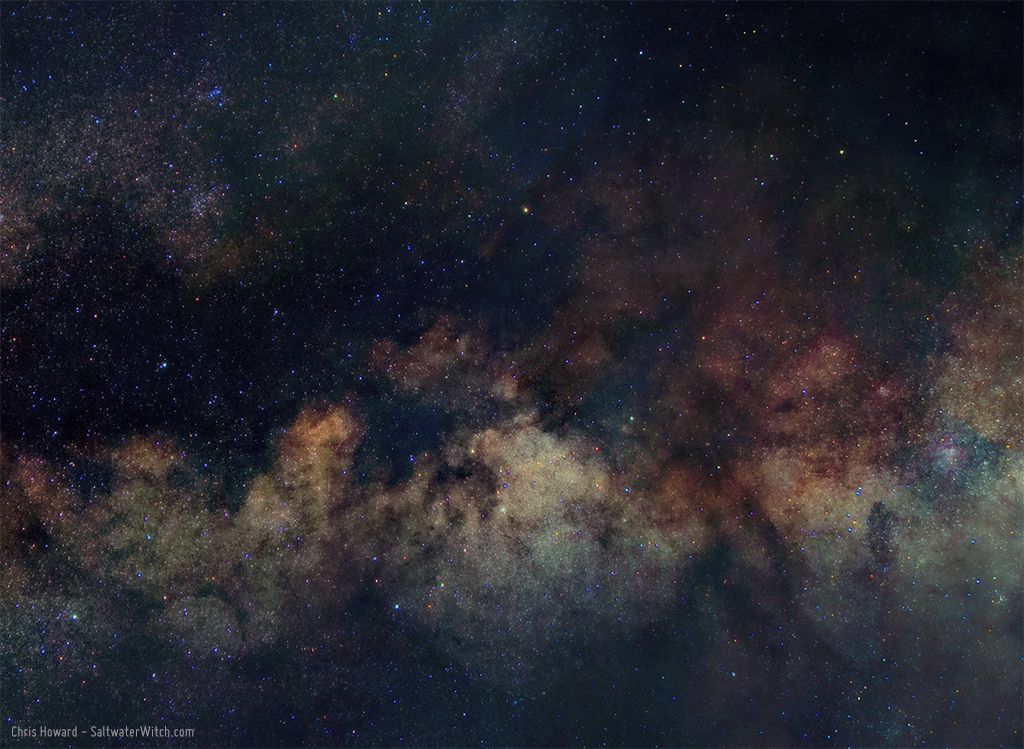
The above shot covers a 30 × 20° FOV of the Milky Way from a little below M17 (Swan Nebula) in the constellation Sagittarius to a little past Delta Aquilae, the bright white star at the bottom left, in the constellation Aquila. Below, is my original shot cropped from M17 on the right to just past Eta Cygni, a variable double star in the constellation Cygnus--about twice the width of the one above. The brightest star in the frame, low center, is Altair.
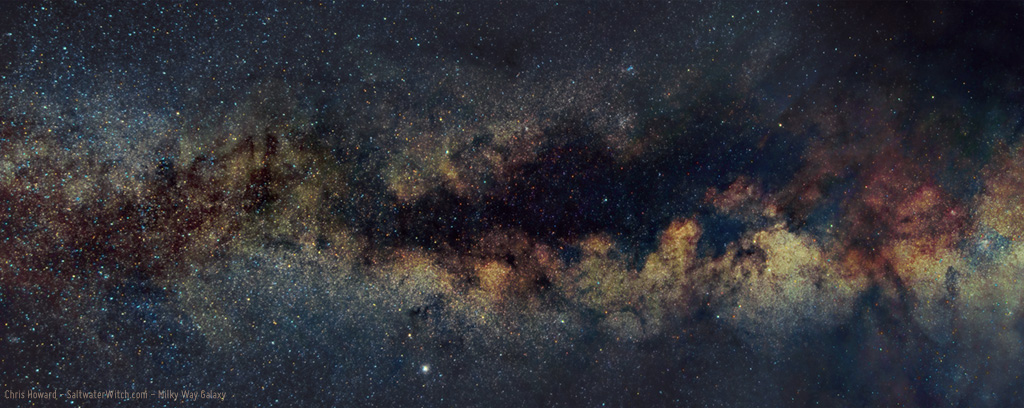
Posted February 11, 2018
Astro Session - November 10, 2017
Constellation Orion (and that's Sirius in the lower left). I was out in the cold last night, with the Nikon D750 (24mm, 30 sec. exposure, ISO 800). Love that Hampton sky glow.

Posted November 10, 2017
Remote Astro - July 24, 2017
I'm down with the LMC--let me hear you say Large Magellanic Cloud. I took some wide field images of a small portion of the LMC, centered on the Dragon's Head Nebula (NGC2035), that colorful stretch of star-forming cloudiness in the middle of the pic. Astro specs: 8 stacked 300 sec exposures, Takahashi SKY90 APO, SBIG ST2000 XMC camera, Paramount PME.
Now, before you go thinking that I've teleported to the southern hemisphere, which is where you have to be to see our nebulous galactic neighbor, the Large Magellanic Cloud, I assure you I haven't. I have merely bought a tiny slice of observatory time on some fantastic hardware that happens to be located at the Siding Spring Observatory, New South Wales, Australia.
I will also tell you that I can fly from here to Australia seven or eight times--first class--for what that equipment setup costs. It's so much easier pretending to be there under the stars near Coonabarabran, using some totally badass astronomical gear. And it's easy, and inexpensive. Besides, it's pouring rain here, and I miss seeing the sky. Wait, I don't have to justify my imaginary stargazing trip to Australia to you! Go check it out yourself: https://www.itelescope.net (The observatory in Spain is lovely as well).
A portion of the Large Magellanic Cloud
